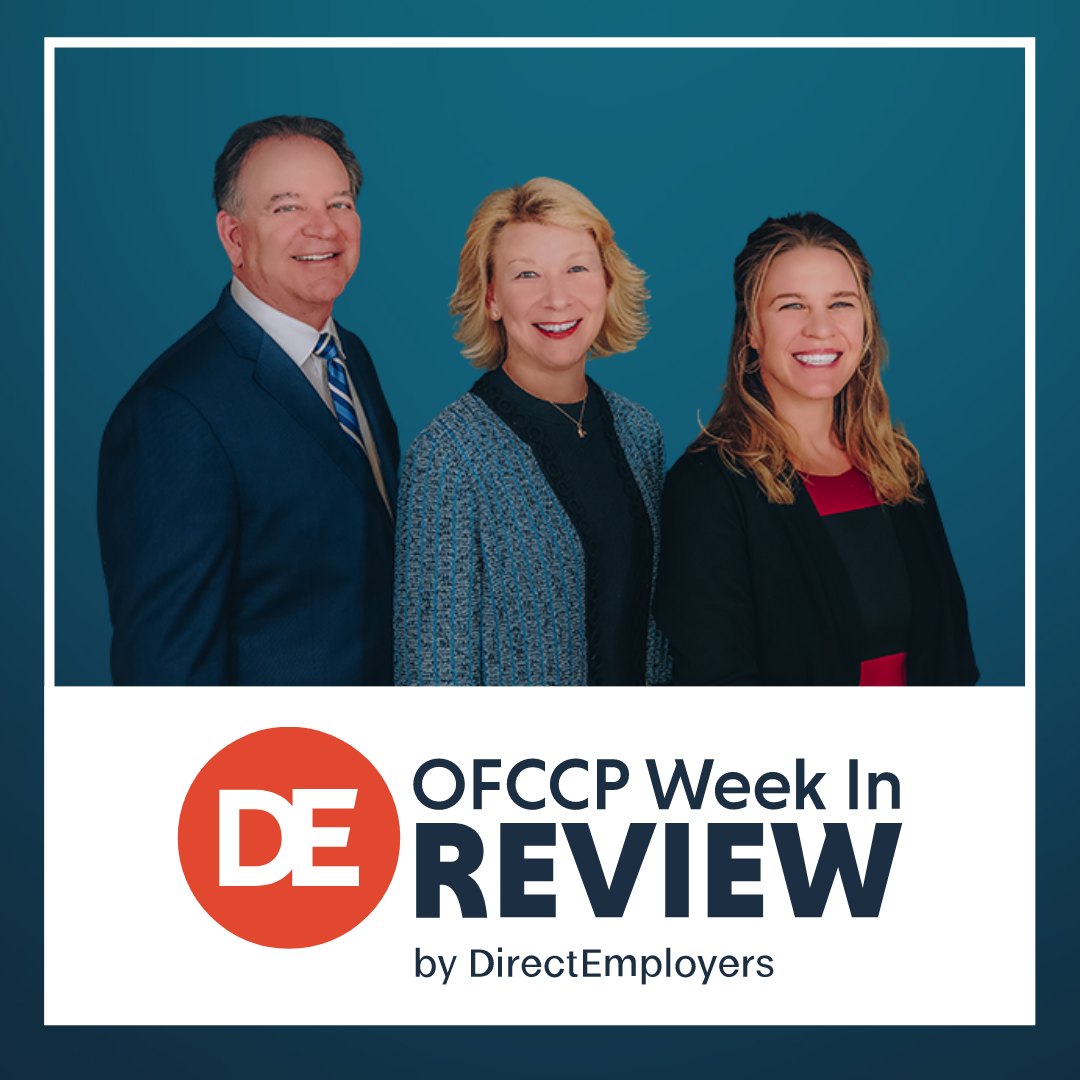 The DE OFCCP Week in Review (WIR) is a simple, fast and direct summary of relevant happenings in the OFCCP regulatory environment, authored by experts John C. Fox, Candee Chambers and Jennifer Polcer. In today’s edition, they discuss:
The DE OFCCP Week in Review (WIR) is a simple, fast and direct summary of relevant happenings in the OFCCP regulatory environment, authored by experts John C. Fox, Candee Chambers and Jennifer Polcer. In today’s edition, they discuss:
- NLRB Standardizes Education for Immigrants of Their Rights Under the National Labor Relations Act
- Mental Health Awareness Month – What Can You Do?
- Free Two-Day Virtual Forum On Construction and Government Contracting
- Department of Homeland Security Extends Expiration of Employment Authorization Documents
- EEOC to Discuss Discrimination and Harassment in Construction – Open to Public Viewing
- EEOC and USDOL To Host Webinar Series on Advancing “Workplace Equity”
- GAO Offered Service Contract Act Enforcement Insights When It Reported Progress to The U.S. Senate Budget Committee, But Also The Need For Further Improvement As To Five Recommendations GAO Made In 2020
- The Great Resignation Moved into an Even Higher Gear as Short-Term and Long-Term Unemployment Both Continued Essentially Unchanged For April 2022, But More Workers Lost Touch
Monday, May 2, 2022: NLRB Standardizes Education for Immigrants of Their Rights Under the National Labor Relations Act
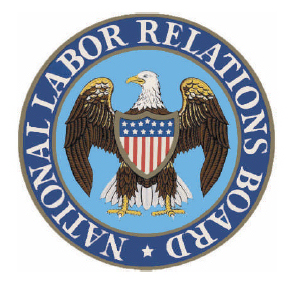
- immigration status is not relevant to whether there has been a violation of the NLRA,
- information obtained during NLRB investigations is protected, and
- a charging party or witness can ask the NLRB to seek immigration relief for employees at a worksite if it is necessary to protect employees participating in NLRB processes or exercising their rights under the NLRA.
The action is part of the initiative she announced in November of 2021 (see our story “NLRB Counsel Seeks To Protect Immigrant Workers Rights.”)
“One of my top priorities as General Counsel is to ensure that NLRB processes are accessible for all workers,” said General Counsel Jennifer Abruzzo. “All too often, immigrant workers are subject to unlawful intimidation tactics that seek to silence them, denigrate their right to act together to seek improved wages and working conditions, and thwart their willingness to report statutory violations. The NLRB will do everything we can to protect immigrant workers to exercise their rights under the NLRA and to pursue any interference with those rights by participating in the NLRB’s processes.”
Monday, May 2, 2022: Mental Health Awareness Month – What Can You Do?
In May, we commemorate National Mental Health Awareness Month. Support mental health in the workplace by connecting with a new public education campaign launched by the Campaign for Disability Employment (CDE), “Mental Health at Work: What Can I Do?”
Tools & Resources
- PSA Outreach Toolkit – features sample language and social media posts to promote the 60-second “Mental Health at Work: What Can I Do?” Public Service Announcement (PSA).
- Download or order the “What Can I Do?” poster.
- Learn about the PSA cast members and view behind-the-scenes video interviews.
- Use the “Mental Health at Work: What Can I Do?” Workplace Guide to learn about exemplary practices for company leaders, managers, and employees. View the interactive guide, or download the PDF version.
- Workplace mental health resources
In Related News
- The U.S. Department of Labor (USDOL) Secretary Marty Walsh and U.S. Department of Health and Human Services Secretary Xavier Becerra met with health insurance and business leaders. The group discussed compliance with the Mental Health Parity and Addiction Equity Act, adequacy of in-network providers, and mental health and substance use disorder treatment during the pandemic.
- The USDOL will hold a Twitter chat on May 11th at 1:00 PM EST to discuss strategies employers can use to promote a mental health-friendly work culture and support workers with mental health conditions. The Agency invites employers, employees, mental health advocates, and anyone interested in promoting workplace wellbeing. Use the hashtag #MentalHealthAtWork.
Tuesday, May 3, 2022: Free Two-Day Virtual Forum On Construction and Government Contracting
The U.S. Department of Labor’s Wage and Hour Division in Dallas announced it will host a 2-day virtual Construction and Government Contracting Forum titled “Build Back Better in Compliance.” The event will consist of a panel discussion on compliance with federal laws governing wages and other workplace issues and agency presentations ranging from 30 to 90 minutes. The meeting will include representatives from the:
- Office of Federal Contract Compliance Programs
- OSHA
- Employee Benefits and Security Administration
- Office of Labor-Management Standards
- Veterans’ Employment and Training Service
- Bureau of Labor Statistics
- Women’s Bureau
- Equal Employment Opportunity Commission
- National Labor Relations Board
- Small Business Administration
- IRS
Event Details
May 17, 2022: 9:00 AM – 4:30 PM CDT
May 18, 2022: 9:00 AM – 4:30 PM CDT
The online event is free, but registration is required.
Thursday, May 5, 2022: EEOC to Discuss Discrimination and Harassment in Construction – Open to Public Viewing

On Monday, May 16, 2022, the Agency will post instructions on its website on how to attend the live-streamed videoconference. There will also be an option for listen-only audio dial-in by telephone. Closed captioning and ASL services will be available.
Thursday, May 5, 2022: EEOC and USDOL To Host Webinar Series on Advancing “Workplace Equity”
More marketing and the twisting of words. The federal government is now using the term “Workplace Equity” to mean doing their jobs, regardless of the agency involved and regardless whether the statutes fail to relate to non-discrimination (like wage and hour) or even whether the agency in question has any statutes to enforce at all (as in the case of the USDOL Women’s Bureau). So, if the employees of a federal agency do their job and enforce the mission of their agency, they now feel they are undertaking “Workplace Equity.” If that is the case, then all private sector HR Managers are “Workplace Equity Managers.”
The Equal Employment Opportunity Commission (EEOC), in partnership with the U.S. Department of Labor (USDOL), announced a free webinar series titled “Advancing Workplace Equity.”
The events are scheduled to take place every Tuesday from May 10th to June 14th, 2022. Times and topics are as follows. The Agency will provide an American Sign Language interpreter. For accommodation requests or other questions, contact Monica Colungaat at (202) 921-2803 or monica.colunga@eeoc.gov.
- May 10, 2022, 11:30 – 1:00 PM EST
Get to Know Us: EEOC and DOL’s OFCCP, Women’s Bureau, and the Wage and Hour Division
- May 17, 2022, 11:00 – 12:00 PM EST
Retaliation: What Employers Need To Know (Employer Session)
- May 17, 2022, 5:00 – 6:00 PM EST
What is Retaliation? (Employee Session)
- May 24, 2022, 1:00 – 3:00 PM EST
Women In Construction
- June 7, 2022, 11:00 – 12:00 PM EST
What Employers Should Know About FMLA & ADA (Employer Session)
- June 7, 2022, 5:00 – 6:00 PM EST
What Employees Should Know About FMLA & ADA (Employee Session)
- June 14, 2022, 5:00 – 6:00 pm EST
Know Your Rights: How to Protect and Advocate for Yourself (Employee Session)
Thursday, May 5, 2022: GAO Offered Service Contract Act Enforcement Insights When It Reported Progress to The U.S. Senate Budget Committee, But Also The Need For Further Improvement As To Five Recommendations GAO Made In 2020
The Government Accounting Office (GAO) is a fact-based federal agency working for the Congress as its nonpartisan “watchdog” and its in-house investigator. One thing you learn about GAO once you are in a federal Executive Branch agency, is that GAO has a memory like an elephant. GAO will come back in later years like a bad date to criticize a federal Executive Branch agency, in ever-so-genteel language, if that agency failed or refused to heed GAO’s recommendations for improvement. GAO can whine for years if it feels dismissed or disregarded. GAO whining at a Budget Hearing can be either good news or bad news: because maybe GAO will support an agency cry for more needed funds to strengthen a faltering program: a federal agency’s first thought always: throw more money at it; fix failure with more taxpayer funding.
GAO’s testimony on May 5 to the U.S. Senate Budget Committee took the form of a 16-page Special GAO Report: “Opportunities Remain for Department of Labor to Improve Enforcement of Service Worker Wage Protections.” GAO’s Thomas M. Costa, Director of the Education, Workforce, and Income Security team at GAO reported that the U.S. Department of Labor’s Wage and Hour Division (WHD) completed 5,261 Service Contract Act (SCA) case investigations in the six fiscal years 2014-2019, leading to over $220 million in back wage collections for employees (an average of almost $37M per year). Note: WHD is responsible to enforce the SCA across all federal government contracting agencies. In an astounding 3,562 of these cases (68%), WHD found some kind of an SCA violation.
Almost seven out of ten violations are among the highest violation rates any federal enforcement agency reports under its organic statutory enforcement authority. This high alleged violation rate suggests widespread federal contractor noncompliance with the SCA. (Compare OFCCP’s 1 out of a million record of even alleged, let alone actually proven, compensation discrimination and alleged unlawful employment discrimination of some sort on average in fewer than 2% of their investigations over the decades.)
In 2,468 (almost 47%) of WHD’s SCA cases, by contrast, WHD found prevailing wage violations. In addition, in 2,920 (55%) of its SCA cases, WHD found fringe benefit violations. Due to serious violations it found, WHD debarred sixty contractors from receiving new federal contracts for three years (so-called “term” debarments, through a sanctions authority unique to the SCA (but who knew? See below).
After reviewing 5-years of results (from FY 2014—FY 2018) in October of 2020, the GAO published a report about WHD’s enforcement of the SCA. At that time, GAO reported that WHD did not consistently share critical information with other contracting agencies, thereby increasing the risk that excluded contractors might get contracts. GAO therefore made six recommendations in 2020 to improve the SCA audit process, including one to help ensure knowledge throughout the federal government contracting agencies as to which federal service contractors WHD had debarred from federal contracting and for what length of time.
On May 5, 2022, GAO Director Costa reflected on how well WHD had absorbed and implemented GAO’s six recommendations. Ok. Not great. Needs more work. WHD blew off GAO. GAO now not happy. GAO now goes bulldog.
The GAO 2022 Follow Up Report
there is still room for improvement. See the immediately below recommendations and “Status” reporting line:
1. Standardize data entry on SCA investigations.
Status: Complete. [This was the “good news” GAO reported and why the headline to this story reported that GAO is only crying about the next five recommendations WHD and the USPS blew off.]
2. Analyze information on enforcement actions, including the debarment processes and outcomes.
Status: WHD developed a revised internal tracking system that contains additional information on SCA debarments. It will provide a year-end summary of debarment information.
Pending: Information about how WHD plans to analyze information on its enforcement actions, including both debarments and compliance agreements. [EDITOR’s NOTE: Ok. WHD is thinking it has only been two years since the recommendation and those were pandemic years, at that. Little meaningful work got done. Yeah, we at WHD really could not, in fact, work efficiently from home, but we are not giving back our paychecks for sliding through the last two years. Lost years. Too bad. Mulligan. Do over. Give us a break. We will try harder. Honest. Just keep sending paychecks.]
3. For the WHD: Collaborate with the U.S. Postmaster General of the United States Postal Service (“USPS”) (which managed to contract with the greatest number of companies (across all federal contracting agencies, including DoD) found to have violated the SCA) to develop and implement written protocols to improve communication and collaboration between the two agencies.
Status: The Agencies developed a draft Memorandum of Understanding (MOU) that outlines protocols and procedures to increase collaboration and SCA compliance.
Pending: The Agencies have not finalized the MOU because of communication challenges.
[Editor’s Note: We just can’t let that one slide by. “Communication challenges.” Really? What does that even mean? That is one of the nicest politically correct newspeak criticisms we have encountered in some time. All the many words available in the English language, so GAO picks this uninformative phrase to hide what it really means? New nonsense speak: like a lawyer who gave you a technically correct answer but did not tell you a darn thing! How does WHD even know what it needs to do to correct whatever the “communication challenge” was? Build an undersea cable from WHD to USPS? Buy the guys at USPS a cell phone? Teach the guys at USPS how to dial the call-back number on their new cell phones?]
4. For the USPS: Collaborate with the Wage and Hour Division Administrator to develop and implement written protocols to improve communication and collaboration between the two agencies.
See above.
[Editor’s Note: Or how about locking the two agency heads in a room for an hour to edit and sign the MOU? Or tell their Mothers to withhold their dinners until they get done and can come down from their rooms to eat? And here we are as taxpayers paying the big bucks for a fancy formal GAO Report reporting what could have been said more directly by simply attaching scene 78 from the movie Cool Hand Luke [“What we have here is a failure to communicate”] to the final GAO report and testimony.
5. Ensure that the unique company identifier designated by the Federal Acquisition Regulation is included in SCA debarment records in the System for Award Management whenever appropriate and available.
Status: WHD developed a tool to allow its SCA enforcement team to retrieve a government contractor’s DUNS number. Regional staff will include the DUNS number with the debarment recommendations, and the national office will record the SCA debarment records in SAM.
Pending: A progress report on the revised process.
Editor’s Note: Surprise! Don’t shoot the messenger, and speaking of improving communication, we hope GAO is aware that the federal government contracting world officially discontinued use of DUNS Numbers as of April 4, 2022, as we wrote about here “The DUNS Number is Out – Federal Contractors Must Secure a New “Unique Entity Identifier” And, geez, the WIR is free to subscribers…
6. Develop written procedures for consistently and reliably informing relevant contracting agencies about findings in SCA investigations that identify violations.
Status: Pending.
[Editor’s Note: And geez, what about that gerund? …” procedures for consistently and reliably informing”… .” How about those words without the gerund? “…procedures to consistently and reliably inform….” Much stronger, shorter, leaner, and crisper sentence….just sayin’ to help a good report move along and get read. Writing counts!]
In the Know – The Service Contract Act
The McNamara-O’Hara Service Contract Act requires contractors and subcontractors performing services on prime contracts over $2,500 to pay service employees prevailing wages (or the previous contractor’s collective bargaining contract rates) and fringe benefits. The U.S. Department of Labor issues Wage Determinations on a contract-by-contract basis as to many, but not all, of the job titles employees perform on and under the federal service contract.
Contracts equal to or less than $2,500 require the payment of the federal minimum wage as Section 6(a)(1) of the Fair Labor Standards Act (“FLSA”) requires. The overtime provisions of the FLSA may also apply to SCA-covered contracts.
See the WHD’s landing page on the Service Contract Act for additional resources.
Conclusion
The Wage and Hour Division
“has taken steps to improve its oversight of the SCA and communication with contracting agencies—for example, by strengthening its ability to track debarments. Nevertheless, certain challenges persist. These challenges hinder its ability to effectively and efficiently enforce the SCA, increasing the chance that workers will not receive pay and benefits to which they are entitled. We will continue to monitor DOL and USPS’ actions in response to our recommendations.”
Friday, May 6, 2022: The Great Resignation Moved into an Even Higher Gear as Short-Term and Long-Term Unemployment Both Continued Essentially Unchanged For April 2022, But More Workers Lost Touch
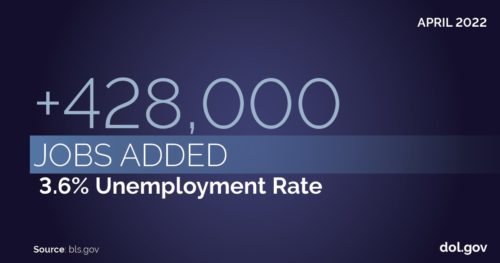
BLS reported that the number of “long-term” unemployment measures stayed about the same, although those workers “not in the labor force who currently want a job” (which BLS characterizes as those who are “marginally attached to the labor force” because they had looked for work in the past 12 months BUT NOT in the last 4 weeks) INCREASED by 262,000 in April to 1.6 million. In other words, more of our “long-term unemployed” workers are becoming more distant from the workforce, month by month.
Where Were The Job Gains, AND Job Losses?
Employment continued to trend up in leisure and hospitality (+78,000), manufacturing (+55,000), and transportation and warehousing (+52,000). However, the number of quits also edged up to a series high (meaning an almost 22-year high) of 4.5 million (+152,000 quits), including 88,000 quits alone in professional and business services. So, the actual job gain for April was in fact only 276,000 (428,000 minus 152,000). These data further reinforce the thesis of this Blog: “The Great Resignation is Becoming a “Great Midlife Crisis.” You will not find that startling admission in the pabulum the writers for Secretary of Labor Marty Walsh write into Press Releases for the Secretary to endorse uncritically crowing about more jobs being created. But at some point, you have to tell the whole story, or your credibility starts to wobble and wane. One step forward, but a half-step back.
Editor’s Note: Economists believe that about 150,000 new jobs each month are needed to allow the U.S. economy to grow at about 2% to 3% per year (the growth rate most economists feel is needed to create a “sustainable” rate of growth of the U.S. Gross National Product) to swallow the rising population of workers graduating each year from the schools and coming into the workforce. This is why “seasonally adjusted” numbers will momentarily become periodically more important as high schools, vocational schools, colleges, and post-graduate schools will shortly empty an estimated approximately four million new workers into the U.S. workforce at the end of the month of May. RECRUITERS: SIT UP and PAY ATTENTION!
Employment showed little or no change in construction, information, and government.
The average hourly earnings for all employees in the U.S. on private nonfarm payrolls rose by ten cents, or 0.3%, to an astounding $31.85 in April. Over the past 12 months, average hourly earnings have increased by 5.5%. In April, the average hourly earnings of private-sector production and nonsupervisory employees rose by ten cents, or 0.4%, to $27.12.
Good News: Veterans now enjoy the highest level of employment (only a 2.9%) unemployment rate among the groups BLS typically measures.
Unhappy News: Individuals with disabilities continue to be the hardest hit reporting group with still over 8% unemployment, as noted below.
|
The Employment Situation – April 2022 |
||||
| Unemployment Rate | April 2022 | March 2022 | April 2021 | Feb 2020 Pre-Pandemic |
| National (Seasonally adjusted) |
3.6% | 3.6% | 6.0% | 3.5% |
|
Women (20+) |
3.2% 5.9% 3.1% 4.1% 3.5% 3.2% |
3.2% 6.2% 2.8% 4.2% 3.4% 3.3% |
5.3% 9.7% 5.7% 7.7% 6.0% 5.6% |
3.0% 6.0% 2.5% 4.4% 3.2% 3.1% |
| Veteran (Not seasonally adjusted) |
2.9% | 2.4% | 5.2% | 3.7% |
| Individuals with Disabilities (Not seasonally adjusted) |
8.3% | 8.8% | 9.6% | 7.8% |
See Also
THIS COLUMN IS MEANT TO ASSIST IN A GENERAL UNDERSTANDING OF THE CURRENT LAW AND PRACTICE RELATING TO OFCCP. IT IS NOT TO BE REGARDED AS LEGAL ADVICE. COMPANIES OR INDIVIDUALS WITH PARTICULAR QUESTIONS SHOULD SEEK ADVICE OF COUNSEL.
SUBSCRIBE.
Compliance Alerts
Compliance Tips
Week In Review (WIR)
Subscribe to receive alerts, news and updates on all things related to OFCCP compliance as it applies to federal contractors.
OFCCP Compliance Text Alerts
Get OFCCP compliance alerts on your cell phone. Text the word compliance to 55678 and confirm your subscription. Provider message and data rates may apply.



 The Department of Homeland Security published a
The Department of Homeland Security published a 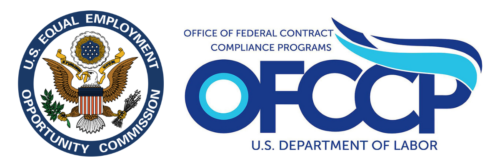
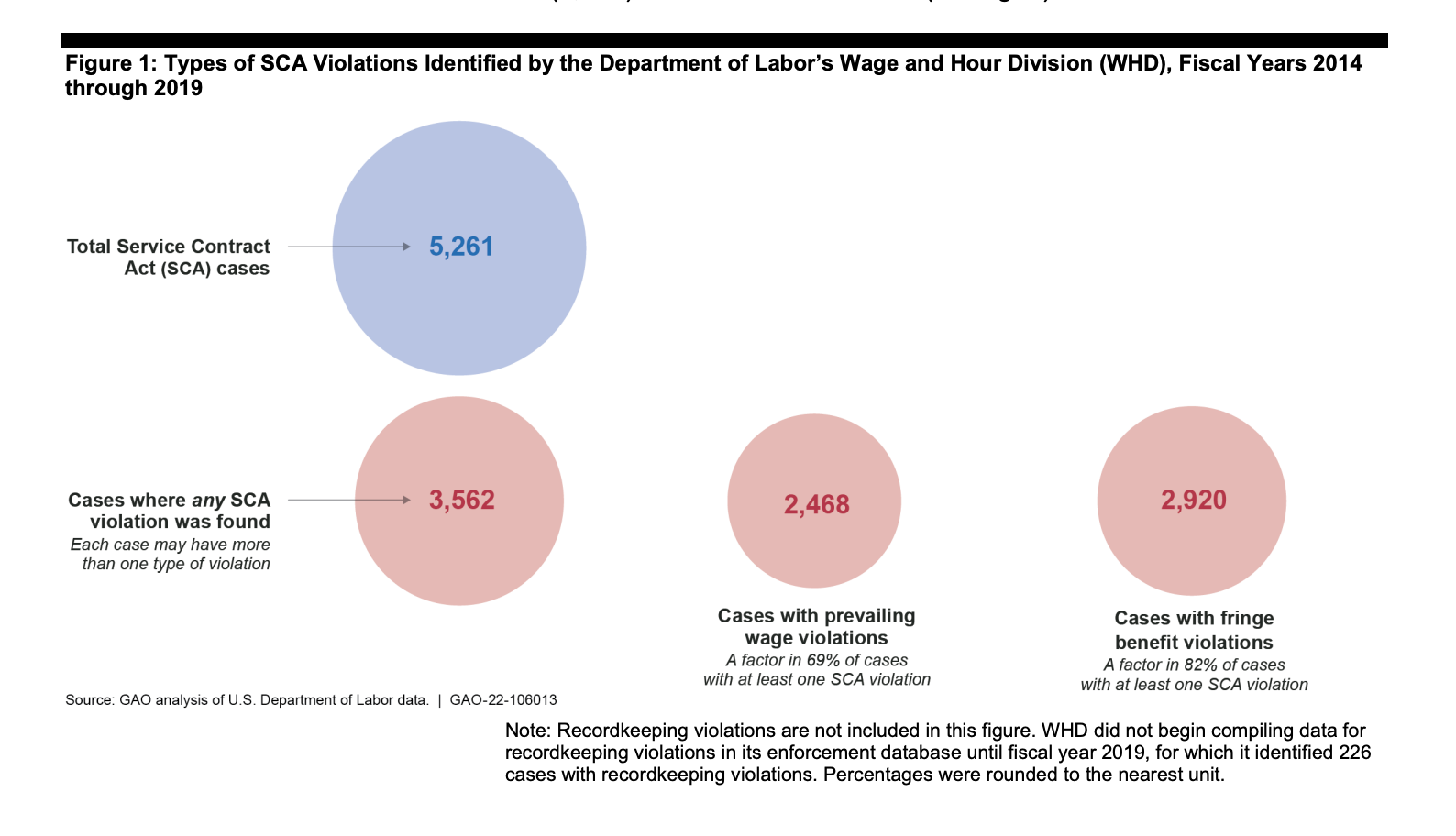

No comment but instead a question. Did Abbruzo provide any evidence to support her “All too often…” claim? If not, is there a cite where I can make inquiry to her?
Thank you
Hank: Good to hear from you again. There was no support for her statement. GC Abruzzo is an ardent unionist and company hater. And, she loves to be purposely provocative.
GC Abruzzo does not make her e-mail address available. Nonetheless, here is here phone number and mailing address: https://www.nlrb.gov/contact-us/headquarters-directory
And here is her personal page on the NLRB website: https://www.nlrb.gov/bio/general-counsel